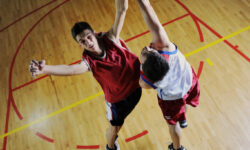
Speed and agility are two qualities that are needed in a wide range of sports. Rugby, football, hockey, badminton, basketball – any sport that involves changes of direction, varied speed or balance maintenance, will benefit from its players working to improve speed and agility.
Speed and agility needed for everyday activities
And it is not just on the sports field that we can benefit. Think about all the times that daily life calls on you to change direction or to shift your position suddenly. You might need to avoid the person on a mission who is bearing down on you with a shopping trolley; the dog might decide to make a dash for freedom; your small child might suddenly take off in the park – there is no telling when you might be called upon to spring into action.
Training to improve your speed and agility can also be a lot of fun and can add variation to your exercise regime.
Variety in training
Speed and agility training should be a combination of exercises that boost explosive velocity, agility, coordination and cardiovascular endurance.
Specific training in these area will make you faster, stronger, and all around more robust. By increasing your speed and agility, you decrease reaction time, but also build stability in ankles, knees, and hip joints, all of which will help avoid common sports injuries.
Below are a set of exercises that you can do two or three times a week as part of your exercise programmes. They can be performed as standalone exercises or as part of a longer session.
Doing this routine while wearing a weighted vest or, where appropriate, holding weights will give you a more intense challenge and will lead to a significant improvement in performance.
The session
Start with 15 minutes of cardio to warm the muscles and help prevent injury and strains. Do each exercise for the set number of repetitions, making sure to repeat the exercise on both sides of the body when necessary. Do the entire workout 2 to 3 times through before stretching thoroughly.
15 Single Leg Lateral Hops (on each leg) – standing on your left leg, hop approximately 20-30 cms from left to right. Once you have completed a set on your left, repeat on your right.
15 Squat Jumps – stand with your feet about hip width apart and knees bent to a 90 degree angle. Jump upwards explosively from that bent position, as you land, sink back into a squat.
15 Single Leg Ventral Hops (on each leg) As with the Lateral Hops, except this time you are moving backwards and forwards.
15 Burpees – Take up a plank position. Bring both knees into your chest, then jump in a vertical direction before landing and kicking both feet back out to plank position. This is the king of the exercises.
15 Lateral Jumps (Keeping both feet together) Feet together, jump lightly from one side to the other.
15 Jumping Lunges (alternating). Start with one foot forward and one foot back. Jump upwards and change leading leg mid-air. As you land, allow your back knee to sink almost to the ground and your front leg bends to a 90 degree angle.
15 Agility Dots (each leg) – Imagine a square on the ground roughly one foot by one foot. Standing on the bottom left corner of the square, using only your left foot, hop to each corner of the square always returning to the bottom left corner. Switch to the right foot and repeat.
15 Mountain Climbers – Start in a plank position and then mimic a running action but with your hands on the ground, so your left knee drives up to your left elbow, then you switch so your right knee comes to your right elbow.
These are plyometric exercises that effectively increase strength, agility and stamina specifically in the leg muscles and ankle joints.
If you are uncertain about performing any of these exercises ask one of our experience trainers at Outlooks Gym.
Remember, after an energetic and challenging workout such as this, it is really important that you remember to cool down and stretch.








